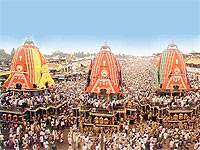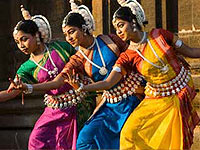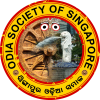Festivals
Ratha Yatra (Chariot Festival)
 The most famous Odisha festival is of course the Ratha Yatra or Car Festival (June-July) which attracts pilgrims and visitors from all over the world. On the full moon day of the month of Jyestha known as 'Snana Purnima', the idols of Lord Jagannath, Balabhadra and Subhadra are brought out and bathed on a pendal known as the SnanaMandap according to religious rites. Then they are believed to become indisposed and are confined to a solitary abode for a fortnight where they undergo 'treatment', are offered special ayurvedic medicine boli and some special liquid diet called 'sarapana'. After a rest of fifteen days, on the second day of the lunar month, the three Lords 'come out' in huge chariots to 'meet' the waiting devotees, marking the start of the Grand Festival known as 'Ratha Yatra'.
The most famous Odisha festival is of course the Ratha Yatra or Car Festival (June-July) which attracts pilgrims and visitors from all over the world. On the full moon day of the month of Jyestha known as 'Snana Purnima', the idols of Lord Jagannath, Balabhadra and Subhadra are brought out and bathed on a pendal known as the SnanaMandap according to religious rites. Then they are believed to become indisposed and are confined to a solitary abode for a fortnight where they undergo 'treatment', are offered special ayurvedic medicine boli and some special liquid diet called 'sarapana'. After a rest of fifteen days, on the second day of the lunar month, the three Lords 'come out' in huge chariots to 'meet' the waiting devotees, marking the start of the Grand Festival known as 'Ratha Yatra'.
Among a series of rituals, of special mention is the 'sweeping' of the chariots by the Gajapati Maharaja of Puri with a golden broom, to proclaim that he is the first of the Lord's servants and on this particular day he performs the duty of a scavenger to demonstrate socialism in action and the dignity of labour. (Legend has it that King Purushottama Deva, Surya-Banshi King of Medieval Odisha, had to once 'suffer' because of this 'sweeper act', when he was denied princess Padmavati by her father.)
The grand Chariots are pulled by thousands of people, irrespective of caste, creed and even religion, to proclaim their universality and accessibility to humanity at large. The deities then go to GundichaGhara (MaausiMaa Mandir) where they remain for eight days, after which Bahuda Yatra (the return car festival) takes place and the Lords return to their abode at ShreeMandir.
 Durga Puja symbolises the commemoration of good over evil. It is celebrated with great pomp and gaiety by Oriyas and Bengalis residing in Odisha. Durga Puja is celebrated in every town and city of Odisha. The three major Pujas of the state are the Chandi medha ("Chandi" means Silver) of Cuttack, Shahid Nagar's Durga Puja and Nayapalli's Durga Puja. Life comes to a stand-still in the city of Cuttack as crowds pour into the Puja Mandaps to enjoy the festivities. On the day succeeding 'Vijaya Dasami', the last day of Dussera, the images are taken in a spectacular procession for immersion in the river Kathajodi.
Durga Puja symbolises the commemoration of good over evil. It is celebrated with great pomp and gaiety by Oriyas and Bengalis residing in Odisha. Durga Puja is celebrated in every town and city of Odisha. The three major Pujas of the state are the Chandi medha ("Chandi" means Silver) of Cuttack, Shahid Nagar's Durga Puja and Nayapalli's Durga Puja. Life comes to a stand-still in the city of Cuttack as crowds pour into the Puja Mandaps to enjoy the festivities. On the day succeeding 'Vijaya Dasami', the last day of Dussera, the images are taken in a spectacular procession for immersion in the river Kathajodi.
Saraswati, who is the patron goddess of learning and arts in Hinduism is worshipped all over India especially in Odisha.
The Puri Beach Festival is conducted by the Hotel and Restaurant Association of Odisha (HRAO), and is a celebration of Odisha, in all its beauty, charm and fun-loving spirit. With events ranging from Fashion shows to rock shows, the Puri Beach festival delights visitors and locals alike. Held on the beautiful beach at Puri, it offers a unique opportunity for visitors to interact with the local populace and enjoy the many splendoured charms of Odisha.
The Puri Beach Festival is co-sponsored by the Ministry of Tourism, Government of India, the Department of Tourism, Government of Odisha, Development Commissioner of Handicrafts and the Eastern Zonal Cultural Center, Calcutta. The festival was started by Mr. K. Singh. Hotels of Puri including the Classified Hotels such as Toshali sands, Mayfair, Hanscoco of Puri much involved in the Festival. All National and International Visitors to the said resorts are invited by the Chairman Puri Beach Festival and the District Magistrate of Puri to witness the festival.
 Described as a poem in stone, the Sun temple at Konark is the crowning glory of the temple architecture of Odisha. As a fitting tribute to the majestic monument, eminent classical dancers of India get together during the Konark Festival every year from 1st to 5th December to present live performances of their art. When the sun sets in the horizon and the stars appear in the sky, the open-air auditorium against the backdrop of the floodlit temple reverberates with the beats of Raga and Tala to fill the air. The classical extravaganza is a journey through ecstasy.
Described as a poem in stone, the Sun temple at Konark is the crowning glory of the temple architecture of Odisha. As a fitting tribute to the majestic monument, eminent classical dancers of India get together during the Konark Festival every year from 1st to 5th December to present live performances of their art. When the sun sets in the horizon and the stars appear in the sky, the open-air auditorium against the backdrop of the floodlit temple reverberates with the beats of Raga and Tala to fill the air. The classical extravaganza is a journey through ecstasy.
Konark Dance Festival is held in December in the beautiful backdrop of the Sun temples in Konark, Odisha. The exquisite 'Natamandir' or the 'dancing hall' of this shrine is an architectural wonder. Every inch of its walls have been covered with fine artistic designs of the ancient times. Musicians playing drums, cymbals and other musical instruments adorn the sculptures in Odissi dance poses.
Bali Yatra Festival in Odisha marks the culmination of all the religious festivities held in the end of the month of Karthik, which is considered the most auspicious month in a calendar year. Held on the full moon day in November - December that is celebrated all over Odisha as Karthik Purnima, Bali Yatra commemorates Odisha's ancient maritime legacy.
Karthik Purnima was considered the most auspicious day by the traders (sadhabas) of Odisha to venture in their huge boats called Boita, on journeys to distant lands like the islands of Bali, Java, Sumatra, Borneo and Ceylon (Sri Lanka). Tourism of Odisha offers tours to Odisha during the Bali Yatra fair and festival so that you can get a glimpse of Odisha's rich cultural history and colorfully vibrant present on your tour of Festivals in Odisha.
Bali Yatra is a hugely popular fair held on the banks of Mahanadi River in the fort area of Cuttack city as well at the seashore at Paradeep. To celebrate the glory of the ancient times, the people in Cuttack as well as in the rest of Odisha float small boats made of cork, colored paper and banana tree barks in the river and water tanks. The ritual of launching tiny paper boats lit by lamps placed within its hollow is known as Boita Bandana.
Dhanu Yatra relating to the episode of Lord Krishna's visit to Mathura is colourfully observed at Bargarh a western Odisha District. Observed for 11 days preceding Pausha Poornima - the full moon day of Pausha in December-January, this is the spectacular Dhanuyatra of Bargarh in the western part of Odisha, about 350 km from Bhubaneswar. Dhanuyatra is the theatrical presentation of Krishna Leela of Devaki with Vashudev till the death of Kansa as described in the scriptures. The entire episode is reenacted.
The town of Bargarh becomes Mathura, the river Jira becomes Yamuna, and village Ambapalli on other bank of river becomes Gopa. A mango grove there serves as "Vrindaban" and a pond, as lake "Kalindi". A gorgeously decorated stage is erected in the heart of Bargarh to serve as the Durbar of Kansa. An elephant is engaged for the royal transport.
The origins of the Dhanu yatra at Bargarh are unclear, but it has been organized since 1948 annually.
Makar Sankranti is celebrated with gusto in mid-January when the Sun enters the orbit of capricon. The sun god is worshipped with great fervour and enthusiasm by one and all. The festival can be best enjoyed at Kalijai (an island in Chilika), Atri, Ghatgaon, Keonjhar, Jashipur and Jagatsinghpur.
The 'Taratarini Mela' one of Odisha's biggest fairs, takes place on each Tuesday of the month of 'Chaitra' i.e. from around mid-March to mid-April at Taratarini Pitha – 30 km from Berhampur. A grand congregation takes place on the 3rd Tuesday.
Observed with much pomp and ceremony in Dhenkanal town, it commences from the fullmoon day of Aswin and continues for a period of one week.
The festival is celebrated in the month of June and goes on for three days. The charm of the festival is more exciting for the young girls. They swing through tied to the trees. This festival brings break in the agricultural activities of the agrarians.
This festival is celebrated on the full moon day of the lunar month of Ashwina bring untold pleasure to the unmarried boys and girls. The worship of moon God is held at home as Janha Mamu (Moon, the maternal uncle.) brings them various delicacies and new clothes.
On every Thursday in the Odia month of Margasir goddess Lakshmi is worshiped with utmost devotion by Odia women. They wake up very early in the morning and clean the house with broom-sticks, for it is believed that goddess Lakshmi would never visit the house if the house in dirty and untidy. The entrance as well as the door step of the house is decorated with artistic Orissan alpana (called chita). a pot made of bamboo canes used in the olden days for measuring paddy (known as mana) is filled up to the brink with freshly harvested paddy. It is believed that goddess Lakshmi visits every house hold during the puja. It is a custom to read out the Mahalakshmi Purana written by ancient poet Balaram Das while performing the puja.
Makar Sankranti and Vishuva Sankranti are observed to celebrate the advent of Spring and the New Year according to the Indian almanac respectively. Vishuva Sankranti is the traditional Odia New Year and generally falls on April 14 each year. It coincides with the traditional New Year in Assam, Bengal, Kerala, Manipur, Nepal and Tamil Nadu - in short the solar Hindu New Year.
The festivals of the Adivasis are a part and parcel of their social life. Their folk tradition and spirit are manifested through the numerous Vratas and Oshas, observed by the Hindus, the former having the authority of the scriptures and the latter being the product of social beliefs and practices, especially those observed by the women folk for the welfare and prosperity of their near and dear ones, for begetting sons, wishing long life of their children, recovery of their Own selves and their near and dear ones from ailments and obtaining salvation. They are associated with the performance of rituals and recitation of a sacred verse tale connected with the occasion, usually elaborating the benefits accruing from the observance of the rites and punishments from the failure to do so. Most of these observances are marked by a spirit of sanctity even among the poorest folk. They clean up the premises and decorate their houses, particularly the spot of worship, with flowers, and draw in rice paste or multi-coloured powders, artistic designs on the floor and walls.
Many of these festivals are held on the full moon and dark moon days thereby confirming the belief in the planets and stars as forces influencing human life.
The priests do not play a part in the Vratas and Oshas; these are usually celebrated under the supervision and direction of women, which testifies to the simplicity, easy belief and tenderness characterising the folk or communal spirit. They help in augmenting the religious or spiritual life of the people enabling them to resist the temptations of the worldly spirit or materialistic way of life. The important Oshas are Jahni Osha, Bodhivamana Osha, Dutia Osha, Sasthi Osha, Khudurukuni Osha, Puajiuntia Osha, Kharkhari Osha, Dhananlanika Osha, Bhaijuntia, Nishamangalavarta Oshat and Kanjianala Osha. The important Vratas are: Sudasa Vrata, Vinayaka Vrata, Rabinarayan Vrata, Sambaradasami Vrata, Somanath Vrata, Savitri Vrata, Nagarchuuthi and Ananta Vrata. Among them Puajuntia and Bhnijiolltia are observed: in the western region, Kharkhari in the southern region. Khudurukuni Osha which is observed by unmarried girls on the Sundays of the month of Bhadrab for the welfare of their brothers is observed in the coastal districts. Another Odia Osha is Prathamastami the eighth day of the month of Margasira on which a rite is held for the life and prosperity of the eldest child who is offered a lighted lamp ovation by the senior Female relatives followed by elaborate rituals during which the Glory of Mahalakshmi is recited.
Raja is another special Odia festival celebrated by girls. It is observed for three consecutive days from the day preceding Jyestha Sankrati to the day following it during which Mother Earth is supposed to be in her menstrual period; it is thus a fertility rite. The girls decked in their sartorial best sway in swings and pray to Mother Earth for their welfare. It is one of the moat memorable festivals of rural Odisha along with Kumara Purnima which is held on the full-moon night of the month of Aswin, soon after Durga Puja. The latter is also celebrated by girls for the well-being of their brothers and for obtaining handsome husbands.
Like Makar Sankranti which is observed by the Adivasis and the non-tribal Hindus alike though in different styles, Chaitra Parva (Chait Parab) is a popular folk festival observed all over Odisha. In western Odisha, the festival held in honour of Lord Siva is called Dandayatra. It is associated with a dance called dandanata commissioned by a household person with a wish, especially for a child. A group of 13 persons, led by their chief called pata bhoku, holding a danda or stick perform the dance. The stick symbolises Lord Siva as Ladudeswara (stick-shaped god). In the coastal region the festival held in honour of either Siva or Sakti is known as Jhamuyatra in which devotees perform penance like walking on fire or a bed of thorns.

